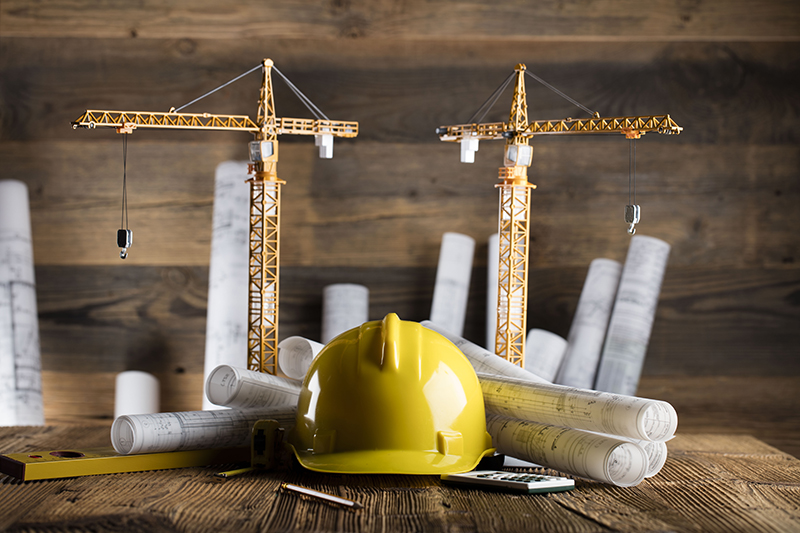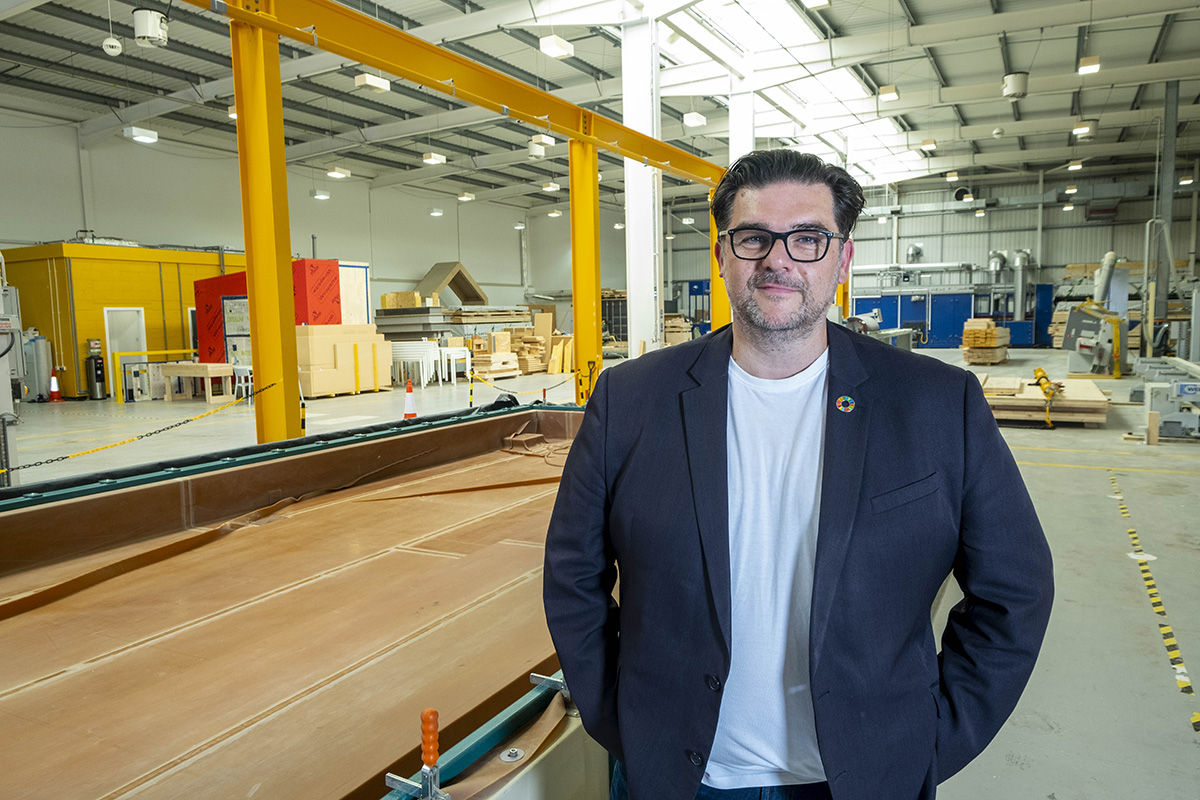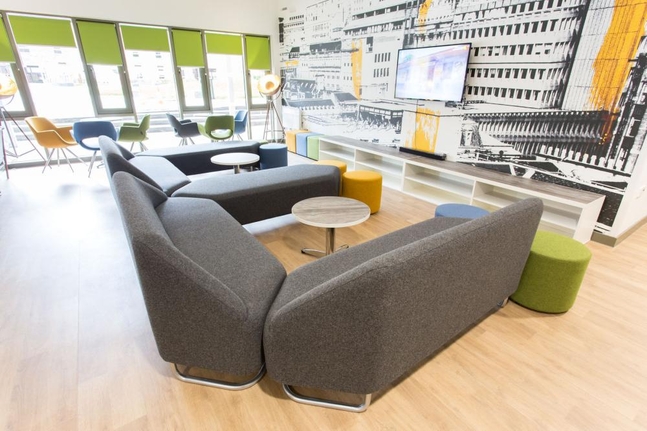
2021 was one of the most challenging years on record for the Scottish construction industry. Material shortages, soaring price rises, the skills gap, and the ongoing impact of the Covid-19 pandemic left businesses across the country grappling with a whole myriad of issues.
It wasn’t all doom and gloom, however. Innovative new products and working practices, thriving order books, progress on sustainability measures, and a strengthening of collaborative problem solving means the industry goes into 2022 with plenty optimism.
Project Scotland recently asked a number of industry stakeholders what their hopes and expectations are for the next 12 months:
Ben Adam, MD of David Narro Associates, wants to see industry inflationary pressures ease to allow clients, contractors, and designers to plan work with more confidence. “As engineers, we have been relatively immune from the direct consequences of the materials and supply-chain shortages, but it will lead to a slow-down in the number of projects getting to site. There has been a huge increase in workload for most consultancies and we have increased staff numbers to manage our way through that – we don’t want to let clients down or over-work our staff. However, it has been challenging finding candidates and the ‘sellers market’ will continue for some time. More normality has crept into the design process with more people returning to the office, and that can only be good for team morale, training, and workload management. All in all, there are excellent reasons to be optimistic going into 2022 and the world rebuilds!”

Peter Reekie, chief executive of the Scottish Futures Trust and chair of the Construction Leadership Forum executive group, said he starts the year optimistic, describing this as a time of ‘great opportunity and transformational change’ for the sector, driven largely by its central role in decarbonisation. “There will be opportunities for the smallest traders retrofitting homes to large programmes and projects delivering energy efficient buildings, district heating networks and other infrastructural adaptions and improvements. These opportunities extend to designers, professionals, manufacturers, and material producers to contribute to sustainability, quality, digitalisation, and whole-life value. My hope is that as leaders focus on these opportunities they also focus on people. More than half of us are over 40, around 86% male and we have a sadly increasing rate of suicide. This must change. Lasting people-focused transformation will be at the heart of the Construction Accord which we intend to set in place between the public sector and the industry this year. I hope everyone will want to be part of it.”

Anne Struckmeier, construction and engineering partner at law firm Addleshaw Goddard, said she suspects the majority of the industry will continue to feel ‘pressure points’, with even greater demand placed on the requirement to deliver sustainable and carbon neutral projects that are achievable within budget constraints. “This, coupled with the shortage of skilled labour, certain materials and talent pipeline across Scotland, has the potential to become detrimental for the sector in a time when regeneration and new infrastructure is vital. Construction output significantly grew throughout 2021 and this is predicted to rocket again in 2022, however the complex challenges that the sector faces could hinder the ambitious goals the industry shares.That said, forward thinking and reactive firms which have navigated the challenges effectively so far will be primed to take advantage of the many opportunities that are on the table.”

Stephen Good, CEO of the Construction Scotland Innovation Centre, said 2022 should be the year innovation becomes mainstream and adopted at scale across all areas. “We need to start taking some of the game-changing pilots and prototypes that have been developed by researchers and industry experts and extend them out into the wider market. For Scotland, in particular, it’s about creating a legacy of COP26 – turning the ideas, concepts, and discussions of November’s conference into tangible action plans and engaging with everyone in the sector along the way. The industry is so interconnected that it makes it difficult to pinpoint one area or specialism in which this mainstreaming process will happen. However, we are beginning to see an important shift in attitudes, with the sector recognising that it needs to be at the heart of the solution to climate change. With that comes more willingness to embrace new ways of working. Ultimately, collaboration and knowledge-sharing will underpin all of that – no one organisation can deliver the required transformation alone.”

Alan Burns, executive director of Glasgow-based construction firm City Building, hopes an increased awareness of climate change will prompt an even greater drive towards sustainable buildings. “I also hope and expect that, with ongoing labour supply issues in the wider industry, construction companies will fully embrace apprenticeships to nurture a nation of skilled workers. In 2021, we recruited 60 craft apprentices and employed 61 former apprentices as trades people. Scotland’s young people have a wealth of potential which could be harnessed to develop the sector’s approach to renewable technologies, while also supporting those most impacted by the pandemic. I hope City Building can continue to be the thriving, positive and forward-thinking organisation we have proven ourselves to be, holding ambitions for carbon net zero, increased female participation in our workforce and providing the best possible service as paramount.”

Nicola Barclay, chief executive of trade body Homes for Scotland, said that as the ‘adrenaline and firefighting’ of 2020 dissipated, 2021 was about members ‘digging deep’ to keep on driving their businesses forward. “The resilience of our sector and its people really shone through. And that is just as well because there will be no shortage of challenges or changes during the coming year – a new planning system, the transition to net zero and local elections to name only a few. Whilst the high level of customer appetite for new homes continues to be sustained, the longer-term outlook remains fragile as uncertainty over the pandemic continues and members are finding it harder than ever to open new sites and get much-needed new homes out of the ground, with the perennial issue of the time it takes to navigate the planning and wider consents process of major concern.”

Gillian Ogilvie, MD of Will Rudd (Edinburgh), praised the industry’s strong performance in 2021, but stressed the need for continued investment from both the public and private sectors to ensure output levels continue to grow. “We also witnessed a real appetite for sustainable development, and the industry stepped up during COP26 to highlight some of the fantastic initiatives and approaches being implemented. The enthusiasm and drive need to continue with the further development of more sustainable solutions and ways of working if we are to protect our planet and meet climate change targets. For the Will Rudd team, this includes the use of carbon calculators at the earliest stages of design, implementing blue-green infrastructure and continuing our work in the renewables sector to deliver low carbon or zero carbon solutions.”

Lesley McLeod, CEO of The Association for Project Safety, has called for 2022 to be the year when construction ‘ups its game’. “It’s strange how, at the New Year, we all spend time looking back. Like those award ceremonies on television, I’ve been reflecting on friends who have left us and the challenges those of us still standing have faced. There has been Covid and supply chain problems, Brexit and skills shortages. I think those issues will remain key features over the next twelve months. And, below the surface of these prevailing issues, seismic shifts are also moving the ground beneath our feet. I think the big growth area will be retrofit. But there will also be a need for more, and better, training to fill the skills gap with home-grown talent. There needs to be more than a cursory nod to equality, diversity, and inclusion to attract and retain the best people. And it must, finally, be time wholeheartedly to adopt BIM helping cut costs, reduce waste, and improve safety.”

Alasdair Rankin, MD of Aitken Turnbull architects, reflected that before 2020, few in the UK construction and built environment sector took account of World Health Organisation briefings and projections when planning the year ahead. “While difficult and disruptive for many the last two years have also been a catalyst for change in our industry. Moving into 2022 we should expect to see some of these changes becoming more concrete; an increase in workspaces being redesigned for a more collaborative and flexible mode of working; progress towards genuine sustainability in the built environment. The need to act is clear and our sector must take an active role in this change; improvements to residential developments to provide healthier, better homes that respond to home working and help to combat fuel poverty. I hope we retain the resilience, flexibility, and humanity of the last two years as we move towards, what I hope will be an exciting post-Covid period.”

Laura Banks, associate director at Gleeds Edinburgh and branch chair of Women in Property Central Scotland, said the Scottish construction market’s recovery has gained momentum across key sectors like office, build-to-rent, retail warehousing and industrial. “The public sector in particular now covers roughly half of Scottish building contracts. A recent example of this is North Lanarkshire Council’s announcement of a £1.2 billion investment plan over a five-year period, focusing on major regeneration for towns and communities. After the advent of huge opportunities like the Edinburgh BioQuarter development plans, and the boost COP26 recently injected into the Scottish market, I hope to see continued progress in 2022. Clients and construction teams should be very astute, however, in deciding when to deliver projects because key material price increases and labour issues from the last year have not settled down yet. Pre-construction period should also not be underestimated, so as to give sufficient time for both design and procurement decisions.”

Allan Callaghan, MD of Cruden Building, believes the sector has weathered the storm and the outlook looks more promising. “At Cruden, we have a healthy construction pipeline, particularly as we are included in a number of important procurement frameworks coupled with a robust housing market across central Scotland. While the housebuilding industry is working at full stretch to regain the ground lost during the last 18 months, we are extremely mindful that climate change has the potential to pose a greater challenge than the pandemic, so we are firmly focused on reducing our carbon footprint while constructing green, energy-efficient homes. We are currently working on one of Scotland’s first affordable Passivhaus developments and designing Scotland’s first net zero carbon housing development. Importantly, the continuous investment in our apprentices and employees is helping to mitigate the logistical difficulties being experienced in delivering on projects. Those difficulties arise from ongoing material and labour shortages which look set to maintain cost pressures.”

Richard Whitfield, head of building consultancy at Knight Frank Scotland, said supply chain shortages and inflation hit the headlines in 2021, causing delays and extra costs to building projects in Scotland and across the UK. “Consensus seems to be that this will likely continue in the first half of 2022, before easing after the summer as supply chains unclog. Anyone working on construction projects over the next six months should expect trading conditions to remain tight and, with that, maintain strong relationships with their suppliers, contractors, and clients. Rising material prices and availability issues may remain unpredictable, but the fact that they are continually changing should no longer come as a surprise and, therefore, need to be built into plans.”

Scott Mackenzie, chair of BDP Scotland, praised the ‘tremendous efforts’ from across all sectors of the built environment to recover from the pandemic challenges and, looking forward to 2022, said he would like to see a continued recovery and even greater confidence to grow the industry. However, he stressed that accelerated growth needs to be achieved through the wider adoption of sustainable solutions. “Following on from COP26, we need to see even greater collaboration and investment to tackle the challenges we face. We need to be actively encouraging developers, investors and organisations to carefully consider adaptive reuse in the first instance before building new as the default option. There is real opportunity to do this, especially as we work to stem the decline of towns and cities across the UK. We need to also be looking to new energy solutions, materials and construction methods to ensure buildings and spaces are delivered to meet environmental and societal needs.”

Aynsley Cheatley, regional MD (Scotland) at Summers-Inman construction & property consultants, highlighted the continuing challenging marketplace as we head into 2022. “There remains a considerable fluctuation in the supply of labour and materials, and ever-increasing costs due to the perfect storm of Covid-19 and Brexit. All these conditions are likely to continue throughout the year and may worsen in the early part of the year due to the Omicron variant, and potential tightening of restrictions. It is not all doom and gloom as the vaccine rollout continues apace which will hopefully assist in bringing back normality to all sectors. Finally, the industry continues to develop at pace with emerging technologies such as artificial intelligence, virtual reality, BIM, 3D printing and robotics and drones to name but a few, playing a considerable part in shaping the future of how we design and deliver construction projects, undertake surveys, etc.”

Ian Drummond, divisional chair of Taylor Wimpey, said the housebuilder’s ambition for 2022 is that its regional businesses in Scotland will continue to deliver high-quality new homes, while creating sustainable communities where people want to live. “We are also committed to reducing labour pressures by attracting new talent to future-proof our business in Scotland, underpinned by training and development of apprentices to fill the emerging skills gap. Throughout 2021 we have been active in the land market, and this will continue into 2022, while remaining fully engaged in the emerging debate around the National Planning Framework (NPF4). We will also continue to consult and provide industry perspective on the changes proposed to current Building Regulations in support of the Scottish Government’s target to make Scotland net zero by 2045.”

Mark Markey, MD of Akela Group, highlighted the positive outlook for 2022, citing the firm’s ‘strong’ order pipeline and expected growth, especially in the housebuilding sector. “The requirement for more housing stock remains and our housebuilding clients are confident as they forge ahead with land purchases to increase the number of units to meet UK housing demand. We will also be looking to achieve growth in the industrial and commercial sectors across both our construction and ground engineering services. While the availability and costs of materials will continue to present challenges, the sector has demonstrated better procurement management over the past two years and we will hopefully see further improvements in 2022. I also hope that efforts across the industry continue to address the skills and resources gap. We’ve witnessed tremendous success with our apprenticeship programme and we are also experiencing greater demand for skills training, particularly ‘green skills’ through the Akela Group’s training arm, TALA Training.”

David Gray, MD of bidding and tender specialists AM Bid, hopes that COP26 will provide the impetus for the sector to lead the drive to net zero carbon emissions by 2045. “Decarbonisation and retrofitting of Scottish homes provides a big chance for the industry to grow through the provision of new opportunities for skills development, apprenticeships and career pathways. “Retrofitting will also provide fantastic opportunities to encourage more young people and women into construction careers, bridging skills and diversity gaps in the sector. As a bidding and tender specialist working with many SME clients across Scotland, I also expect there to be an increased number of opportunities for SMEs to bid for work in the public and housing sector supply chains. Many SMEs are highly specialist, qualified businesses, who bring reliable, high-quality expertise to the industry and will be critical in helping Scotland to deliver the necessary decarbonisation work that is needed in the coming years.”

Hannah Smith, ICE Scotland director, said that although the ‘spectre’ of Covid remains, there is hope that 2022 will be a more positive year for everyone both personally and across the civil engineering community professionally. “We’ve seen – through landslides, derailments and power outages – the need for continual investment in our infrastructure. It’s not always about building new, but making sure the networks we rely on are fit to underpin a flourishing economy and indeed a vibrant society. That’s at the heart of our ambitions for the year ahead, but our biggest aspiration is something we have campaigned on for well over a year – an infrastructure resiliency audit. We know the Scottish Government has said resiliency is a priority but an audit – conducted in a holistic way by bringing together a ‘quadruple-helix’ of expertise from the public, private, third and academic sectors – would help us collectively assess weaknesses and create a cross sectoral plan of action to address them.”

David Shearer, MD of HFD Construction, also has the environment in mind, highlighting that following the COP26 conference in Glasgow, HFD expects sustainability in construction and property to be the ‘pre-eminent theme’ in 2022. “The built environment accounts for a significant amount of the UK’s carbon emissions, which is something the industry needs to address head-on through the use of new construction methods, alternative materials, and the use of green energy throughout the construction cycle – from manufacturing building products to the maintenance of buildings. We are aiming to do our part through the use of energy efficient – as well as recycled and recyclable – materials at our current development at 177 Bothwell Street in Glasgow, working with our supply chain to minimise emissions. We also committed to being a founding member of the UK Green Building Council’s Scotland network, which was launched at the conference.”

Alan Wilson, MD of electrical trade association SELECT, is hoping for further progress being made in the regulation of the electrical industry. “It is frustrating that despite our move towards an electrically-driven economy, anyone can still call themselves an electrician and work in our nation’s homes, despite holding no qualifications. Such a situation needs addressing now, so I would like to see more politicians committing to make Scotland safer. The issue of late and withheld payments also continues to impact those further down the supply chain, so hopefully we will also see progress to improve cashflow to the people who really need it. One thing is for sure – collaboration will be key to making any of our wishes a reality. Covid-19, Brexit and economic volatility have all shown that we can only overcome obstacles by working together, so my final wish is that the industry continues to operate in the spirit of cooperation that has seen us through these unprecedented times.”

Jason Lister owner/MD of Advanced Traditional Screeding Ltd, hopes that price increases will stabilise, resulting in stabilisation of materials and labour costs. He added that this will reduce delays on site, helping companies to make proper financial plans for the future. “We believe the construction industry is driving the economy. But while there is always the fear that Covid may again hit the industry hard, we are hopeful that if it is kept under control, we can keep our growth strategy on track. To diversify our portfolio, we have made inroads into UFH and TLA, both of which drive an eco-friendly solution and comply with the upcoming government directives and changes to building standards, and we remain in a positive frame of mind for 2022.”

Fiona Harper, the secretary, Scottish Joint Industry Board, hopes the upturn in skills and training in the electrical industry continues. “Last year saw the number of electrical apprentices and adult trainees beginning their studies in Scotland reach a 12-year high, with more than 800 new learners enrolling on the electrical installation apprenticeship and adult trainee programmes. It’s great to see so many people eager to learn and we must ensure we keep encouraging all genders, ages and races to consider an electrical career. It’s also gratifying to see so many employers willing to take on apprentices and help nurture the talent of tomorrow. The industry as a whole is committed to the next generation, and I would like to see even more employers playing their part and helping to create a pool of highly-trained, highly-qualified personnel that will help take their business – and the sector – forward.”

Paul Kelly, MD of Glasgow-based AS Homes & Briar Homes, said the industry has rebounded strongly from the impact of the pandemic, adding that although progress is ‘dampened’ by the shortage of material supplies and labour along with increasing costs, there is need for optimism. “At AS & Briar we are remaining positive as we have a strong pipeline of sites for homes in the private and affordable sector. We start the year as one of the first UK housebuilders supported by a Regional Growth Initiative which invests up to £10 million of equity alongside Briar, our private housing arm. We are targeting new sites for family housing in the private sector and we currently have three sites awaiting planning approval. To meet the Scottish Government’s ambitious target to deliver 100,000 new affordable homes by 2032, we hope to see a more streamlined planning process. This will allow AS Homes to complete developments like the one in Glasgow’s Calton district which provides 80 much needed energy efficient, high quality affordable flats for the community.”

Nick Waugh, director of Shawfair LLP, developing the masterplan for the new town and community of Shawfair on Edinburgh’s doorstep, revealed that spending more time and working from home has changed expectations. “As well as a higher demand for extra space and gardens, homeowners are keen on access to outdoor space beyond their own home. Just 15 minutes by train from Edinburgh and with acres of green space, Shawfair provides an opportunity to experience the best of both worlds. Our housebuilding partners report they are experiencing very high demand for new homes at Shawfair, much of which is fuelled by homeowners looking to escape the city for more space and a better quality of life. With 30% of the homes already built or in development, the next phase of the masterplan will widen Shawfair’s appeal introducing modern apartments near the town centre, with shops, offices, schools, a new community campus and places to eat. Our vision is to attract a vibrant mix and choice for residents by building a sustainable community at Shawfair.”

Fiona Hodgson, CEO at SNIPEF, cited skills and renewables as two key areas in 2022. “The low carbon ambition of both the UK Government and devolved nations will undoubtedly secure work for plumbing and heating engineers into the foreseeable future. To meet this demand those already in the industry will need to upskill and there is added urgency to increase the number of apprenticeships if we are to secure a skilled and competent workforce able to design, install and maintain low carbon technologies. My hope for 2022 is that we attract a more diverse range of people into an industry which will make a real positive contribution to climate change and social wellbeing. Furthermore, I would like to see additional financial support and/or tax breaks for employers who employ apprentices but who often struggle with the costs involved. The government ambition is for 600,000 heat pumps to be installed per annum by 2028 and for new and replacement gas boilers to be phased out by 2035 at the latest. While the ambition is commendable, without a clear route of how we will achieve this, it is simply a statement. While heat pumps are one solution other low carbon heat systems also need to be considered and I would like to see other technologies such as hydrogen forming part of government policy. To stimulate demand and confidence from consumers additional funding support will be necessary and levels of competency need to be stipulated for all installations to ensure quality.”

Graham Taylor, sales and marketing director at ceiling solutions manufacturer Zentia, said it seems likely that the year ahead will be tough for the industry, with Covid-19 set to continue to push supply chains to the limit, with the UK facing ‘unique’ additional pressures as we adapt to our post-Brexit reality. “Having said that, we see a wealth of opportunity ahead, particularly in refurb and retrofit as property owners and designers look to improve working environments. Architects and designers are continuing to focus their attention on the sustainability of the products they specify, and we don’t expect that to change. There are design trends that we see accelerating. Building owners and designers are looking for less traditional ceilings – islands, canopies, baffles, as well as more industrial finishes like metal mesh. We’re hoping to capitalise on that. It’s sure to be an exciting twelve months!”












